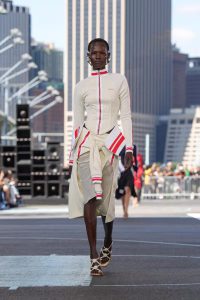If you take a walk down the Gibbs-Green Pedestrian Walkway on Jackson State University’s campus, you might run into a few girls that have an exotic head full of hair extensions. But many do not know that keeping in the tresses for too long can result in major problems.
More than ever, women are getting hairstyles that many celebrities wear. One of the most popular styles girls are wearing now is called a sew–in.
According to WiseGeek.com, a sew-in weave is a type of hair extensions that is typically done at beauty salons where either real or synthetic human hair is sewn onto small, tightly woven braids against the scalp. Many people believe that these extensions look more natural that other types, such as wigs or clip-on hair. In most cases, a sew-in weave will last for at least three months before it must be taken out.
However, wearing a sew-in longer than two months can have some serious affects on health and hair. It can result in hair loss, fungi and mold development on the hair and scalp, and matting.
Some students shared their views on how they feel about the wearing of hair extensions for a long period of time.
Sattia Breckenridge, a freshman communicative disorders major from New Orleans, La., said she had a horrible experience when she wore hair extensions for too long.
“I had left my sew-in on my head for four months one time. I had a random girl do it and washed it, it had matted. I eventually had to cut my hair. Now I wouldn’t wear my sew-in longer than two months. I take it out, leave it out for a week, and put it back in,” said Breckenridge.
Jamon Thomas, a freshman mass communications major from Belzoni, Miss., shared his male perspective on what he thinks about the trend of girls wearing hair weave for long periods of time.
“I don’t like weave, I like natural hair. I don’t see the point of paying for something that you are going to take out of your head in a couple weeks,” said Thomas.
Inez Doe, a JSU alumna, virgin hair distributor, licensed cosmetologist and owner of U Fancii Beauty Bar in Jackson, Miss., shared a professional approach on how to deal with your hair extensions as busy college students.
“A sew-in shouldn’t be left in for more than 2 months, and a quick weave no longer than 2 to 3 weeks. After every hair service I recommend trimming your ends and deep conditioning. If the style exceeds past 2 months, you’re going to run into excessive shedding, excessive matting and tangling of your natural hair when you take it down. It can result in horrible split ends and dry brittle hair,” said Doe.
After you take it down:
1. Brush the hair and make sure you get out ALL the excess dead hair and dandruff.
2. Use a wide tooth comb and oil the scalp.
3. Do a deep conditioning before you shampoo, it prohibits your hair from matting.
The college budgets of many college girls often lead to the patronage of unlicensed beauticians to save cash.
Doe said that this is one of the worse things a person can do because it can cause major hair breakage.
“The installation is important. These girls are letting their friends put in their hair, that is damaging your hair right there. You should always go to a professional to get a sew-in style done,” said Doe.
She added: “Quick weaves should always have a protective shield base as well as a stocking cap. If you do a sew-in, I recommend that you use a wig net base that keeps from sewing your extensions to your actual hair which is good for minimal hair breakage.”
If you would like to know more about the caring of your natural hair and extensions or would like to purchase new Brazilian hair bundles you can contact Inez Doe at 601-790-0297.www.ufancii.com.
Keeping weave styles in for too long can cause problems
More from VarietyMore posts in Variety »
- NFL selects Kendrick Lamar as Superbowl LIX headliner, sparking mixed reactions
- Bold innovation and art merged during New York Fashion Week 2024
- Movie release celebrates Coraline’s 15th anniversary
- Shrek 2 returns to theaters for 20th anniversary commemoration
- WrestleMania 40 breaks records as the greats return to finishes stories






Be First to Comment